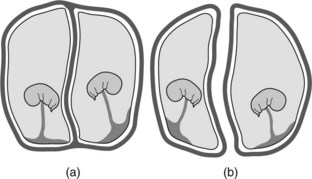Chapter 21 Twins and multiple deliveries
TYPES
Monozygotic or monochorionic twins (uniovular/monovular/identical)
These are produced when one ovum divides to form two fetuses (Figure 21.1a). They can be dichorionic diamniotic, monochorionic diamniotic or monochorionic monoamniotic. The monozygotic twinning rate of 3–5 per 1000 is similar for all ethnic groups (the fetal sex is always the same). Complications such as hydramnios, fetal abnormality, discrepancy in fetal weight and fetal transfusion syndrome, are more likely, as are intrapartum complications and poor perinatal outcome. When one twin dies in utero there is a 25% risk of neurological and renal lesions and even intrauterine death in the survivor.
Dizygotic twins (binovular, non-identical)
With dizygotic twins, two ova are shed, usually in the same menstrual cycle and fertilised by two different sperms (Figure 21.1b). The fetal sex can differ. Twinning rate differs in different ethnic groups and is influenced by the use of fertility drugs to induce ovulation.
DIAGNOSIS
COMPLICATIONS OF TWIN PREGNANCY AND DELIVERY
Stay updated, free articles. Join our Telegram channel

Full access? Get Clinical Tree



